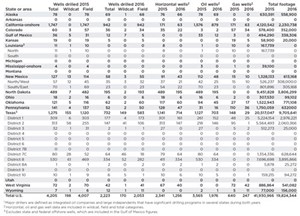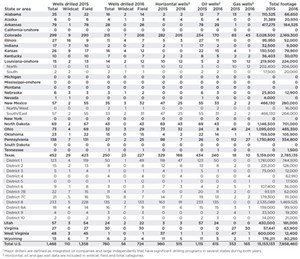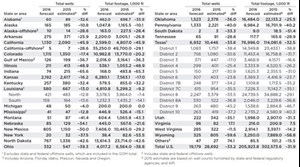As budgets collapse, U.S. drilling may shrink to a 17-year low
Who knew? After the rapid decline in crude oil prices from mid-2014, most analysts expected 2015 to be a year of recovery, when prices would creep back toward $70/bbl. In actuality, as a few of us feared all along, the oil price predicament has gone from bad to worse.
A recent body blow to the upstream oil-and-gas industry has been the lifting of Western sanctions against Iran. The prospect of an additional 500,000 bopd entering the already saturated markets made oil traders drop the Brent and WTI price down below $30/bbl several times between mid-January and early February 2016.
Not surprisingly, U.S. E&P firms have taken it on the chin, cutting back drilling plans frantically, with shale operators particularly hard-hit. Indeed, the rapidity with which prices fell in the last two months caught many operators off-guard. As of early February, many oil-and-gas companies had still not issued final guidance regarding their drilling and development plans for 2016, as they tried to figure out how bad the market might become. Meanwhile, down the supply chain, equipment and service companies announced additional rounds of layoffs by the thousands, as they tried to stop the financial bleeding.
Given these fundamental economic realities, and the analysis of our proprietary surveys of operators, U.S. state agencies, and additional third-party sources, World Oil forecasts the following:
- U.S. drilling will drop 33.2%, to 19,179 wells, which would be the lowest number since 1999, when just 18,700 wells were drilled.
- U.S. footage will go down 31.9%, to 206.0 MMft, which is the smallest amount since 2003, when about 186.2 MMft were drilled.
- U.S. Gulf of Mexico E&P activity, particularly focused on long-term deepwater activity, will continue at a very lower level.
- Many U.S. operators, particularly small and medium-sized independents, but also some fairly large independents, will refrain from drilling entirely this year.
MORE BUDGETARY CUTS
As we have done for a number of years, we feature an extensive upstream spending survey from chief analyst James West at the Evercore investment firm. He and his team have analyzed actual spending for 2015 and planned expenditures for 2016. During the current round, they received responses from about 300 companies worldwide. One of the problems that they’ve had this year, is that oil prices took a dive immediately after they released their initial report in December. So, they had to release an update the following month.
As regards the U.S., they expect a 40-to-50% drop-off in E&P spending this year. This marks the second, consecutive, major drop in capital spending. North American market costs are down 20-to-50% across the board, but Evercore believes that this pricing will be less permanent than some perceive, because capacity will tighten, due to attrition. Evercore’s analysts also believe that a locational shift may be underway, as some producers are likely to concentrate their efforts away from the Williston basin, and more toward the Eagle Ford and Permian. For more details, please see the capital expenditures article on page 43.
OPERATOR SURVEYS
World Oil surveyed 13 major U.S. drillers (integrated companies and independents with large drilling programs) and 105 independent operators (a cross-section of small and medium-sized firms) working in various states. Together, these two groups represent 5,673 wells, or roughly 20% of all U.S. drilling in 2015, and 3,003 wells, or about 15.7% of all activity forecast for 2016. Their data yielded some eye-catching trends, a few bordering on historical proportions.
Among the major drillers, 4,205 wells were drilled nationwide, of which just 198, or 4.7%, were exploratory, Table 1. This year, these companies will decrease their drilling 47.1%, to 2,223 wells, including 170 for exploration. Last year, 2,341 (55.7%) of the total wells were horizontal completions. This year, that share will grow slightly, to 56.5%. In addition, 84.8% of all wells last year were oil-directed. This year, 88.9% of this group’s wells will be oil-directed. Average footage drilled per well in this group was 9,971 ft last year, and this figure is actually expected to fall during 2016, to 8,918 ft/well.
In the independent group, 1,468 wells were drilled during 2015, of which 110 (7.5%) were exploratory, Table 2. This year, these independents will drill just 780 wells, a 46.9% reduction in activity. Of this amount, 56 wells (7.2%) will be drilled for exploration. About 68% of all wells drilled last year were horizontal, and that share will fall a bit, to 66% in 2016. The share of wells that targeted oil during 2015 was 73.9%, somewhat less than that of the major drillers group. This year, the share of drilling that targets oil among smaller independents will be 76.2%. Average footage drilled per well by independents in 2015 was 10,322 ft, and this figure is set to fall, to 10,075 ft/well in 2016. This reflects the trend among smaller independents to return to drilling more shallow, vertical oil wells.
One particular trend that is worth mentioning (and which is somewhat disturbing and depressing) is that many operators responding to World Oil’s survey have given up on drilling entirely for the balance of 2016. For instance, the number of responding companies that drilled at least one well in 2015, but which will not drill at all this year is 15. However, there are an additional 40 companies (nearly two-fifths of the survey group) that did NOT drill in 2015 and which will also NOT drill in 2016. Keep in mind, with maybe two exceptions, all of these companies drilled at least one well during 2014.
U.S. FORECAST
Taking a look at World Oil’s forecast of 2016 U.S. wells and footage (Table 3), we predict a nationwide 33.2% reduction in drilling, from the 28,692 wells drilled during 2015. If our prognosis for 19,179 wells is realized, 2016 will be the only year since the 1930s, other than 1999, in which U.S. drilling will fail to break the 20,000-well mark. And, given recent announcements, by some operators, of greatly reduced plans, there is certainly the possibility that this decline could be a little larger. Meanwhile, we expect footage drilled to fall at a slightly slower rate, dropping 31.9%, to about 205.9 MMft of hole. More than a third of all footage will be drilled in Texas.
GULF OF MEXICO
As we suspected a year ago, the original prediction by the U.S. Bureau of Safety and Energy Enforcement (BSEE) that drilling in the Gulf would drop to just 144 wells proved to be too low. In reality, operators drilled 199 wells, said BSEE. This year, the agency is predicting just 100 wells, which we again think is too low. Accordingly, we are calling for 126 wells. Last year’s drilling in the Gulf totaled 3.5 MMft of hole.
The wave of major projects in the deepwater Gulf continues. Last April, LLOG Exploration initiated production from its Delta House FPS in Mississippi Canyon Block 254. In addition, Stone Energy last summer drilled and completed its Cardona #6 development well, and tied it into existing Cardona field subsea infrastructure. Also, during March 2015, Exxon Mobil put its Hadrian South field onstream, tying back two wells to the nearby Lucius project. Last, but not least, Noble Energy’s Bend and Dantzler fields went online in late 2015, ahead of schedule and within sanctioned budget.
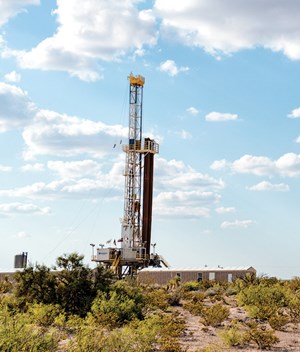
First production from Shell’s Stones field, ultra-deepwater project is still on track for later this year. In November 2015, the Turritella FPSO for Stones set sail from Singapore to its final destination in the Gulf of Mexico. Meanwhile, Exxon Mobi’s Julia field deepwater development is still expected to go onstream in late 2016 or early 2017. Noble Energy said that it expects first production from Gunflint field by mid-2016. Several more projects anticipate first oil in 2018, while an impressive list of additional discoveries awaits final investment decisions.
U.S. SHALE PLAYS
Liquids-rich shale plays have borne the brunt of low crude oil prices, although operators have made some headway in reducing their relatively high break-even costs. In addition, many of the leading U.S. independents that dominate these plays are restricting their focus to the so-called sweet spots that contain the best portions of these reservoirs. Consequently, some impressive wells with high IP rates continue to be drilled in the Permian basin and Eagle Ford shale, as well as the SCOOP and STACK plays in Oklahoma.
STATE-BY-STATE ACTIVITY
Looking at individual states, Texas is bracing for an overall 33.6% decrease in new well activity, to 6,932 wells. Much of the loss will occur in District 8 (Fig. 1), which includes the Permian basin (down -33.5% to 2,247 wells), as well as District 1, featuring the Eagle Ford shale (-38.4% to 1,083 wells), District 7C (-35.5% to 615 wells) and District 2 (-30.6% to 756 wells). Despite fears that diminished drilling activity could cause oil production to dip precipitously below 2.5 MMbpd, Texas remained the national leader last year, with output remaining well above 3.0 MMbpd.
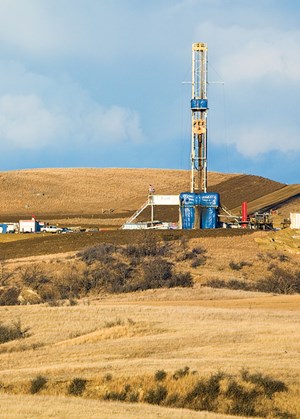
Including its share of federal OCS output, Louisiana remained above 1.4 MMbopd last year, despite dire predictions to the contrary. Nevertheless, our forecast expects the state to suffer an overall 13.0% drop in the number of wells drilled to 580. The southern portion of the state, which is devoted primarily to conventional oil drilling, will be particularly hard hit, with a -13.6% reduction.
North Dakota’s output peaked above 1.2 MMbopd in December 2014. Yet, despite a severe reduction in drilling (Fig. 2), in the oil-rich Bakken shale, the state’s output held steady, at above 1.1 MMbopd throughout last year. World Oil expects drilling during 2016 to drop 42.6% to 767 wells. In January 2016, leading operator Continental Resources said it would spend 35% of its capital budget, to run four rigs in the Bakken and drill 26 wells. These levels are far less than the firm’s activity just two years ago.
Oklahoma is known for encompassing both conventional oil, and shale oil and gas production. Yet, this diversity in activity will not spare the state from suffering a 36% reduction in the number of wells drilled, to 1,523. The state’s oil output peaked in April 2015 at 463,000 bopd, and was below 420,000 bopd by late in the year.
Although Pennsylvania had been hit less hard last year, due to being the core of the giant, gas-rich, Marcellus shale (Fig. 3), the wave of spending reductions (sparked by very low oil and gas prices) has now caught up with the state. World Oil estimates that drilling in the state will fall 40%, to 1,333 wells.
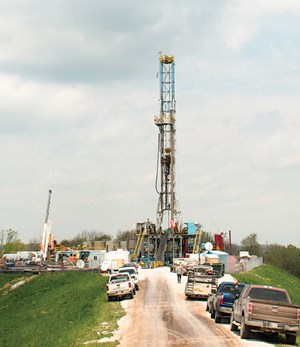
1. Field production from onshore Alaska has declined from 1.974 MMbopd in February 1988 to just 459,590 bopd in 2015. The best opportunities for future production growth have been cut off by the federal government’s actions to prevent exploration in the 12 million acres of the Arctic National Wildlife Refuge (ANWR). Nevertheless, the rapid deterioration of Alaskan oil output has prompted a significant uptick in drilling. Activity was actually up 1.5%, to 199 wells, of which 185 were onshore. The vast majority of drilling was oil development wells.
Offshore, in state waters, activity remained relatively steady at 14 wells, with all of them devoted to development. This year, a reduction to 10 wells is expected by state officials.
2. Activity in the Golden State is dominated by a handful of firms, including Aera Energy, California Resources Corp., Chevron and LINN Energy. And, more than ever, these firms are concentrating their efforts almost entirely on drilling shallow, conventional oil wells. Despite the focus on these relatively cheap wells, we expect activity to plummet 45.9%, to just 1,130 wells. California’s oil output has shrunk slowly from a recent peak of 568,000 bpd in November 2014, to 537,000 bpd in October 2015.
In the Rocky Mountain region, the Niobrara shale dominates the largest state, Colorado, where it will prompt a cut in activity of about 17%. In New Mexico, activity is being hammered on two fronts—gas in the northwest, and oil in the southeast, principally in the Permian. Overall, we see the region being down about 32%. ![]()

- Coiled tubing drilling’s role in the energy transition (March 2024)
- The last barrel (February 2024)
- Digital tool kit enhances real-time decision-making to improve drilling efficiency and performance (February 2024)
- E&P outside the U.S. maintains a disciplined pace (February 2024)
- Prices and governmental policies combine to stymie Canadian upstream growth (February 2024)
- U.S. operators reduce activity as crude prices plunge (February 2024)
- Applying ultra-deep LWD resistivity technology successfully in a SAGD operation (May 2019)
- Adoption of wireless intelligent completions advances (May 2019)
- Majors double down as takeaway crunch eases (April 2019)
- What’s new in well logging and formation evaluation (April 2019)
- Qualification of a 20,000-psi subsea BOP: A collaborative approach (February 2019)
- ConocoPhillips’ Greg Leveille sees rapid trajectory of technical advancement continuing (February 2019)

